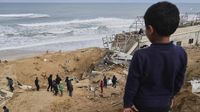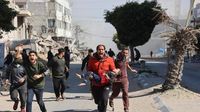In a significant escalation of hostilities in Gaza, Israeli forces targeted the Nasser Hospital in Khan Younis on March 23, 2025, resulting in the deaths of at least two Palestinians and injuring several others. This strike is part of a wider offensive aimed at dismantling Hamas leadership and is marked by a series of military actions following the collapse of a previous ceasefire.
According to the Israel Defense Forces (IDF), the airstrike was aimed at Ismail Barhoum, described as the "new prime minister of Hamas in Gaza," succeeding his predecessor, Issam Daalis, who had been killed just days earlier. Israeli Minister of Foreign Affairs, Israel Katz, confirmed that the offensive would persist until hostages held by Hamas are released. Katz’s statement reflects the ongoing Israeli strategy to cripple Hamas's operational capabilities.
Following the end of a temporary truce on March 18, the situation in Gaza has escalated dramatically. Reports reveal that over 600 Palestinians have died since the truce ended, bringing the total death toll to more than 50,000 since the onset of conflict in October 2023. As documented by local health authorities, the violence has not only affected adults but has also resulted in the tragic death of entire families, including children.
In the early hours of March 23, additional Israeli military operations in southern Gaza reportedly killed around 40 individuals. Among those who lost their lives were women and children, highlighting the devastating toll of the ongoing conflict on civilian populations. The Palestine Red Crescent Society has decried the situation, stating that they were prevented from accessing those injured in the attacks, exacerbating the humanitarian crisis on the ground.
Mustafa Gaber, a local journalist who witnessed the events unfold, described the evacuation process under heavy fire from tanks and drones. "It’s an evacuation under fire," he expressed in a video call, recounting how hundreds of civilians were fleeing Tel al-Sultan while artillery fire echoed in the background. Describing the precarious situation, he stated, "There are injuries among us. The situation is very difficult." This narrative underscores the chaos and fear permeating the streets of Gaza.
In a grim development, the Israeli army has further enforced evacuations, particularly in the city of Rafah along the Egyptian border. Residents have been ordered to leave their homes due to impending operations in the area. Colonel Avichay Adraee, a spokesperson for the IDF, urged the population to vacate areas that were deemed risky, warning, "Staying in your homes or camps puts your life in danger." Such statements reflect the army's ongoing mandate to eliminate perceived threats while navigating the complexities of civilian safety.
Hamas has confirmed the death of prominent political leader Salah Bardawil during the same wave of attacks, indicating an ongoing pattern of targeted killings that have left significant figures within the organization vulnerable. Bardawil's death, alongside that of his wife, marks yet another casualty in the continual toll of violence, contributing to fears of further retaliation from Hamas.
As the death toll continues to climb, two hospitals in southern Gaza reported receiving 17 bodies following nighttime attacks, which included entire families. The European Hospital identified victims, including parents and their five children, who tragically lost their lives during the strikes. This growing humanitarian crisis has drawn international concern. The United Nations (UN) has issued a stark warning regarding the blockade of humanitarian aid, expressing that, "There's no food left, we're on the brink of famine." The UN's alert highlights the dire conditions faced by ordinary Palestinians who are struggling to survive amidst ongoing assaults.
The cyclical pattern of violence began after ceasefire negotiations in January ended without a resolution. While an agreement in January temporarily halted fighting for 15 months, the renewed hostilities have left little room for humanitarian relief efforts, with humanitarian groups reporting restricted access to aid. During the previous ceasefire, significant exchanges took place, including the release of 25 Israeli hostages and the return of the remains of eight others, but the continuation of conflict has thwarted any hopes for lasting peace.
As Israeli forces position themselves around strategic locations within Gaza, including the indica of continued military objectives, the outlook appears increasingly grim. Both officials and analysts suggest the confrontations could extend as the Israeli government faces internal pressures from far-right factions advocating for a decisive approach to eliminate Hamas entirely.
Furthermore, the recent events have seen a resurgence of support for Hamas from Yemeni Houthi rebels who, despite ongoing bombardments from the United States, have resumed strikes against Israeli targets. This unfolding geopolitical situation indicates a deepening crisis that threatens to entrench divisions and prolong suffering in the region.
With tensions continuing to rise, and the death toll reaching staggering heights, the international community watches, albeit with growing distress and calls for renewed dialogue. As the flames of conflict reignite, hopes for peace in Gaza seem distant, leaving many to wonder what the future holds as millions of lives remain in jeopardy. The need for urgent humanitarian access persists, as does the quest for a pathway toward stability and resolution in a fractured land.





